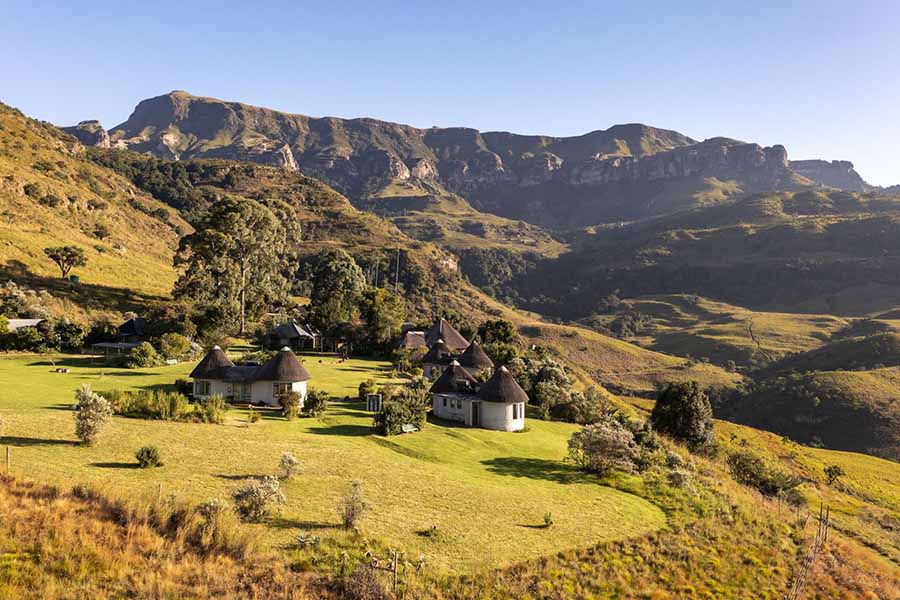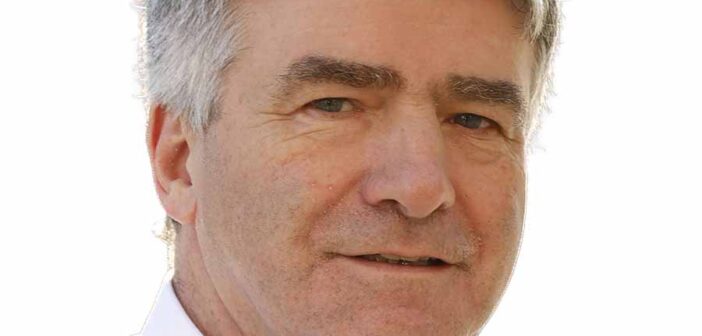| “The grasslands golden, the rocks and cliffs streaked red and silver, the light crystal clear, the sky azure, the massive wall of the Drakensberg blue-grey.” – Dervla Murphy (1931-2022). |
Few places in the world match the Drakensberg mountains for physical beauty. Some say it was the inspiration behind the phantasy setting for The Lord of the Rings, written by South African-born JRR Tolkein.
The wining characteristic of the Drakensberg is how high and steep they are. South Africa’s highest mountains, with panoramic passes, valleys, rivers, waterfalls, and forests, characterise the landscape of what was known as the Eastern Transvaal in the bad old days.
The entire area offers opportunities for hiking, horseback riding, bird-watching, golfing, and fishing. Divide your time in the Northern Drakensberg Nature Reserve between the area’s two outstanding lodges, the Cavern and the Montusi Mountain Lodge. Each provides a magnificent setting, breathtaking scenery, renowned dining, stables of horses, fishing gear, and top notch service, with a nearby adventure centre offering quads, zip lines and mountain bikes
In addition, there are hikes to waterfalls, caves and a world famous rock sculpture, nearby villages and a ground breaking schools project to visit, and the world-famous Kruger National Park is an easy day trip away.
Northern Drakensberg Nature Reserve
It has been a year since the new Northern Drakensberg Nature Reserve was officially declared, so we were tempted to come and check the delights of rural KwaZulu Natal. It is remote. Fifty kilometres to the nearest petrol pump. Did we say remote?
The Northern Drakensberg Nature Reserve, was formally gazetted on April 18, 2024. The park spans 6,500 hectares in South Africa’s Drakensberg Mountains, a UNESCO World Heritage site renowned for its dramatic landscapes, biodiversity, and cultural heritage.
Two things happened in quick succession to transform Northern Drakensburg. The first was the arrival of a Superherd of Eland. It was not be accident. The process started with the removal of fences by the local lodges and farmers. Two cousins owned the farms on either side, and a cooperative man in the middle all agreed to remove offences. The eland who had migrated here from the neighbouring province of Free State began to stay for longer and breed happier. Nowadays, they wander the plains like days of yore and happy hikers are the ones they are most likely to meet along the way. You cannot avoid them. The pizza delivery man on his way to the Cavern Resort hit one in the dark when he was on his return journey. He was then chased down the hill by an angry and bruised eland. He has not been since. Scene and not herd.
The Reserve protects critically endangered grasslands (less than 3pc of South Africa’s grassland biome is conserved) and unique alpine vegetation, including proteas, heathers, and rare orchids, especially vibrant during the blooming season. Many are wheelchair-friendly, with some trails accessible to all. Some areas, like Sentinel Car Park, require 4×4 vehicles for rough roads.
Visitors may spot zebra, reedbuck, or klipspringer in adjacent reserves.There are also endangered vulture colonies, and other grassland animals benefiting from expanded migratory corridors.
The established resorts in the reserve include The Cavern and Montusi Mountain Lodge, run by cousins, the Carte family who have been in the hospitality business for 75 years. We stayed in both, staying two nights in each..
Cavern Drakensberg Resort
The Cavern Drakensberg resort is the larger of the two. Located in a valley beneath the Hlolela and Sugarloaf Peaks, the resort borders the Amphitheatre, a UNESCO World Heritage Site, with dramatic cliffs and rolling grasslands. Guests wake to those mountain vistas, vibrant valley sunrise and birdsong.
It has a higgledy piggledy split level design, ascending the slope in a hesitant manner, with facilities scattered around it like the beautiful pool at the bottom and the treatment room on a height above. Further up the mountain there is a dining area, at the end of a pleasant round-the-hill hike for guests who opt not to have breakfast in the conventional dining room.
The path around the resort dispenses forest trails, one to the cavern that gives the resort its name and a waterfall, with a cannibal legend from the days King Shaka hunted existing tribes to near extinction and a group of them began to starve in their cave.
En route to these magical mystery tours, keep an eye out for the eland and other animals.
Weaving bird tales
The hilltop was traced in a peculiar shade of sunrise red as I climbed the short hill to the lodge to join the birding walk. The angle of light managed to light and rouge each blade of grass across the mountains. A small group of people were gathered to join David Weaver’s bird expedition. Fairy lights hanging on the tree made it feel like Christmas.
A retired high school teacher with an equally adept ear for birdsong and for the soundbite, Mr Weaver conducted us through the gardens and the forests pointing out the huge variety of birds, 43 in all. The background music was the call of the Cape turtle dove: “work harder, work harder” (or as a drinking companion once suggested: “drink lager, drink lager.”) and the ubqitous hadeda (sung, and pronounced, haw-dee-daw), the alarm clock of South Africa.
There are more: 213 bird species to be found, marquee bird types like the chorister robin-chat and Gurney’s sugarbird. After the trek with David Weaver we will never look or listen to a bird in the same way again.
The Cavern is 3.5 hours from Johannesburg (360 km) and 3 hours from Durban (280 km) via tarred roads, making it easily accessible. It’s 10 km off the Bergville–Royal Natal National Park road, with transfers available from operators like EZ Shuttle or KZN Transfers.
Accommodation
The resort provides a range of accommodations to suit different preferences, All accommodations are thatched and designed to blending with the natural environment:
- Standard Rooms: Set in lush gardens, these en-suite rooms feature king-size or twin beds, tea/coffee facilities, and patios for soaking up mountain views. No TVs are provided to encourage immersion in nature.
- Superior Rooms and Suites: Located in tranquil gardens or overlooking the Fern Forest, these spacious rooms include private patios, fireplaces, TVs, and bar fridges. Superior suites offer four-poster beds and luxurious finishes, ideal for honeymooners or those seeking indulgence.
- Family Units: Designed for families, these units provide extra space and access to child-friendly amenities.
In the Cavern our lodge, number 73, a little downhill from the main area and a pleasant stroll to the pool (frequently visited). The room was deep and brighter than is normal in Africa, two couches and double door to a balcony overlooking a manicured lawn with the forest beyond, a desk with tea and coffee facilities and (unused) TV, the bed draped in mosquito netting as African beds often are (at 2,000m, we are at too high an altitude for malaria).
Gourmet dining
The Cavern operates on a full-board basis, offering a table d’hôte menu with a variety of dishes, including vegetarian options (guests should notify reservations in advance). Meals are served in the main dining room, with three-course dinners featuring dishes like fillet mignon with roast potatoes.
- Guests can enjoy meals with views of the surrounding valleys, fostering a communal atmosphere where families and friends connect.
- The resort organises tours to view Bushman paintings and rock carvings. Daily hikes cater to all fitness levels, from gentle strolls to challenging treks. Popular routes include Thonsela Cave, Cannibal Cavern, Echo Cave, Sungubala, Tugela Gorge, and the top of the Amphitheatre. Guides share insights on local flora, fauna, and San rock art, some dating back over 3,000 years.
- Features include a separate children’s dining room, trained nannies during adult meal times, and daily afternoon entertainment like face painting, crafts, and group play. A fenced outdoor play area, trampoline, jungle gym, and pony rides twice daily keep kids engaged. Canoes and fishing are available at the dam, and a small kiddie pool complements the main pool.
- A Tuesday and Thursday morning playgroup is open to valley children and guests outside school holidays.
- The Forest Spa, set high in the indigenous forest, offers massages, facials, and other treatments amid the sounds of mountain streams. Guests can relax in hammocks, read in the library, or browse the curio shop.
- The resort is wheelchair-friendly, with some accommodations and facilities designed for accessibility. Wheelchair-friendly hiking trails are also available in the broader Drakensberg region.
As a founding member of the NDNR, gazetted in 2024, The Cavern supports conservation of the region’s grasslands, water sources, and biodiversity. The reserve ensures water security for millions via the Tugela River and protects cultural treasures like San rock art.

Sungubala Eco Camp
The nearby Sungubala Eco Camp has another set of thatched residences and dining and common areas, and a pool with a view. From here we trekked to see a sculpture, the silent woman, a rock carving crafted in the 1950s by artist and wanderer, William Chalmers.
Montusi Mountain Lodge
In Montusi Mountain Lodge, our room, number 11, came with a separate suite and bedroom The sweeping view of the mountains offered a 240° panorama where the colours changed by the hour. The bed was stacked with five pillows. The bath robe with some flowers and a notice on water preservation telling you to keep the robe for the duration of your stay. There was a kettle and a separate coffee pot with Solenne tea Ruba tea and filter coffee with some traditional South African rusks. The bath had a delightful little jar of African scented soap you could spread like sugar out of a bowl. Another delight: the fridge was stocked with a jug of milk (not UHT). There were two pool towels and an umbrella, and a television which remained, in our case, unused. This being winter, there was a gas fire and a lighter. A thatched roof a theme of both Cavern and Montusi resorts, continued throughout the lodge. The little house came with an adjoining garage to park the car for day trippers.
The lodge offers 16 free-standing suites, designed for privacy and comfort, all with views of the Amphitheatre:
- Garden Suites (10): Feature a 16 m² bedroom with a king-size or twin beds, a 6.5 m² en-suite bathroom with bath and walk-in shower, and a 16 m² lounge with a gas fireplace, TV, DVD player, and private patio.
- Mountain Suites (2): Larger, modern suites with a 20 m² bedroom, 12 m² bathroom, and 25 m² lounge, offering a crisp, contemporary design and enhanced space.
- Family Suites (4): Accommodate four adults with two bedrooms (one with a king-size bed and bath, the other with twin or king-size bed and shower), a shared lounge, and private patio.
- Self-Catering Cottages: Limited units for 4–6 guests, equipped with stove, fridge, microwave, and underfloor heating, serviced daily (excluding dishwashing).
- Suites are decorated in earthy African tones, with thoughtful touches like fresh flowers, homemade truffles, nougat, and complimentary welcome drinks. Amenities include tea/coffee facilities, bar fridges, and optional minibars. Each suite has a private carport.
- The lodge is wheelchair accessible, with some suites and facilities designed for ease of access.
Gourmet Dining:
- Meals are served in a spacious, thatched restaurant with log fireplaces and escarpment views, earning a Chef’s Hat in the Portfolio Collection. The daily-changing menu features imaginative local cuisine, such as panko-crumbed mushrooms, braised bush pig shank, lavender cheesecake, and salted caramel popcorn ice-cream.
- Breakfast includes a cold buffet, full English options, croissants, and a signature daily dish, served from 7:00 AM to 10:00 AM.
- Special dietary needs (vegetarian, vegan, gluten-free, lactose-free) are catered to with prior notice. Private dining under a fairy-lit acacia tree is available for romantic evenings.
- The bar offers reasonably priced South African wines and a lively atmosphere for guest interaction.
Activities:
- Hiking: Daily guided morning walks (free, with tea/coffee and cookies) explore the estate’s highlights, including Montusi Mountain, Bushman Cave (with ancient San paintings), Waterfall Cave (with summer shower opportunities), and rock pools for wild swimming. Self-guided trails are available on the estate and at nearby resorts like The Cavern or Royal Natal National Park (15 km away).
- Horse Riding: The Northern Horse, based on the estate, offers tailored trails for all skill levels, from gentle trots to exhilarating gallops into river valleys. We rode the mountain plateau up and down steep descents
- Fly Fishing: Three dams stocked with trout and bass provide catch-and-release fishing, exclusive to Montusi guests (bring your own rod and tackle).
- Mountain Biking and Trail Running: The estate is part of a 100-km Northern Drakensberg trail network. Sunset trail runs are offered on Mondays, Wednesdays, and Fridays at 17:00 (summer) or 16:15 (winter).
- Bird Watching: Guests can spot kingfishers, bald ibis, and lapwings from their verandas or during dam strolls, with indigenous gardens attracting diverse species.
- All Out Adventures (4 km) offers ten types of activity, we tried out the zip line and quad biking.
From the Mahai Campsite, visitors can follow the signposted path toward the Cascades, a series of terraced pools. It was winter. We still took a refreshing dip under the backdrop of the Amphitheatre, a 5-km crescent of 1,000m cliffs with Tugela Falls, visible on clear days, claiming to be the world’s highest waterfall (previously rated second highest at 983m). It is a dribble compared with more famous waterfalls. Angel Falls in Venezuela need not worry about the accolades.
The park contains San rock art sites, though these require guided tours (book via the visitor center). The area’s history, including its role as a water catchment, is highlighted in interpretive displays.
The visitor center offers basic amenities, including restrooms, a small shop, and picnic areas. Mahai and Thendele Camps provide camping and chalet options for those extending their stay.
The Cascades
Daily guided or self-guided hikes explore the Sungubala Valley and other parts of the NDNR. Popular trails include Jackal Hill, Bishop’s Inkaba, Echo Cave (2–3.5 hours), and the challenging Sungubala Challenge (10 km, 5 hours, 530m climb to Sungubala Mountain’s summit). Trails are well-marked, passing forests, rivers, and Bushman paintings.
A 100-km mountain biking trail network is accessible with permits purchased nearby. Trails cater to casual and energetic riders.
Nearby attractions include Amphitheatre Golf Course (8 km), and Royal Natal National Park (20 km) for Tugela Gorge hikes and San rock art. Cultural visits to Basotho Cultural Village, Golden Gate National Park, Clarens, and Spioenkop Battlefield (from which the Kop in Anfield derives its name) are within an hour’s drive.
From the nearby hills you can see Witzieshoek, where Roger Casement’s brother Tom contributed so much to the invention of Drakensberg tourism over a century ago, about an hour by road but much shorter as the White-Backed Night Heron flies.
The NDNR plans to create a conservation corridor linking Sterkfontein Nature Reserve and uKhahlamba Drakensberg Park may introduce new wildlife viewing opportunities or educational programs about species like the bearded vulture.
The NDNR’s partnership with WWF and WildTrust aims to integrate communal lands into the conservation corridor.
Khanyisela Project: child-centred schooling
Thobani Ndlovu came north from coastal KZN below Durban to head up the Royal Drakensberg Education Trust, funded and inspired by Megan Bedingham, a teacher. Ms Bedingham says that they also created a school where their own family could go: “child development is the best way to transform a society, we’ focussed on the first thousand days, the whole thing is is actually about to develop in neurological pathways of the brain and making sure that children can actually learn.”
The Khanyisela pre-school Project, as it is more correctly known (“Royal,” somewhat controversially relates to England’s king, and not, as you might expect, to Zulu royalty) focuses with the goal of providing quality education to children in a rural, disadvantaged area, as the mission statement says “holistic, world-class educational opportunities for children from infancy to 10 years, enabling them to learn2read and read2learn.”
The double-storey Royal Drakensberg thatched school is based in a repurposed sandstone barn on the road to the Cavern Lodge. Children are catered for pre-primary) to Grade 4. The school initially planned to extend to Grade 7 but has focused on pre-primary and foundation phases due to greater need in rural areas. The curriculum nurtures academic, personal, and social development to help children reach their full potential.
The Khanyisela pre-school project organizes workshops and training sessions for pre-school teachers from the amaZizi community. In 2019, over 40 teachers participated in workshops held at The Cavern. Each term, three Khanyisela pre-school teachers are hosted for two-week training sessions at the Royal Drakensberg Primary School. These sessions focus on sharing teaching methods, improving classroom practices, and fostering professional development.
The project collaborates with local pre-schools to provide resources and guidance, addressing the lack of infrastructure and materials in rural settings. It promotes foundational skills like early literacy and numeracy, critical for children’s long-term academic success, especially given that 80pc of South African Grade 4 children struggle with reading comprehension. Outdoor educational activities, such as bird watching, water safety, and horseback riding, augment the curriculum.
The Trust organises events like the Big5Hike, an annual fundraiser at The Cavern to support the school and early childhood development programs. Hikers raise a minimum of R9,000, with funds directly supporting educational initiatives. Activities like Arbour Day (planting indigenous trees) and Sports Day (with events like wheelbarrow races) foster environmental awareness and community spirit.
The aim is to equip children for better secondary school opportunities, particularly in Pietermaritzburg. The school’s focus on early childhood development is driven by data showing 80pc of South African Grade 4 children struggle with reading, highlighting the need for strong foundational education. When Thobani Ndlovu brought us to Sivuleleni to meet the pre-schoolers, they queued to give him a hug.




